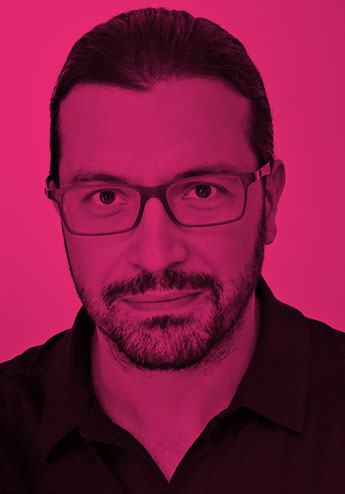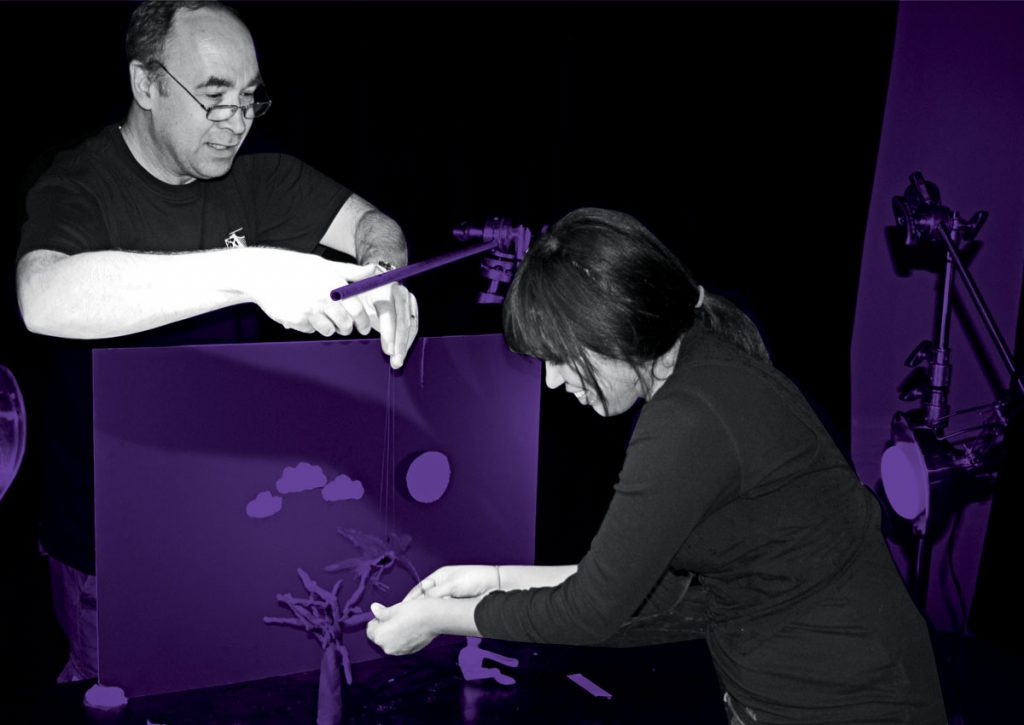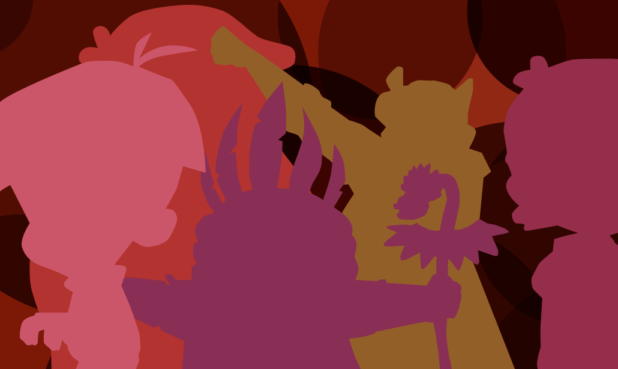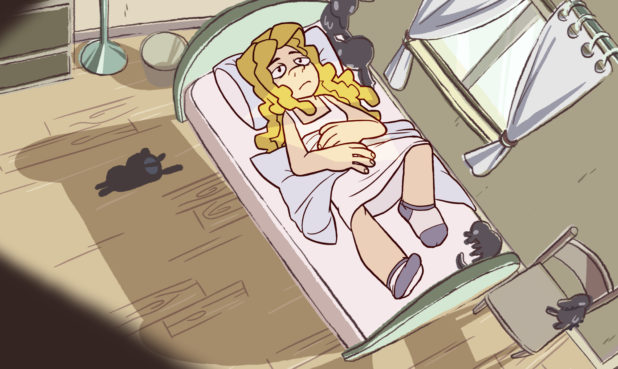Lindsey Pollard

“I am in awe of my student’s talent, diligence and kindness.
I get a window into the future and I like it.”
Ever since running the craft hut as a summer camp counselor in high school, Lindsey Pollard has wanted to teach. “I come from several generations of teachers,” she says, “and the original plan was to teach full-time, but I stumbled into animation while in college and had an immediate change of heart.”
That life swerve paid off, most tangibly in the form of two Emmy wins. A start in track reading and animating led Pollard to her most recent job as a storyboard supervisor on the Cartoon Network’s Summer Camp Island. While she loves her craft, she finds another aspect of her work equally rewarding—the camaraderie.
In short, Pollard is a people person, and it is this quality that drew her to join the Character Animation faculty at the California Institute of the Arts. She feels that the days of old-school lectures are on their way out, and that students want practical as well as artistic advice. “I have personal experience. I can talk about the culture of the industry,” she says. “What makes a good coworker, meeting deadlines, asking for help, setting goals, talking about money. Some of these issues are uncomfortable yet they are universal so we might as well discuss them in a safe environment.”
As for the benefits of teaching her passion, Pollard says: “On the long drive home, I take the time to absorb what has transpired in the classroom because it does have an impact on me. It’s still amazing to me that we can use shapes, lines and color plus time to change how a viewer feels. I hope I never lose that sense of magic animation holds, and I hope my students know it too. I am in awe of their talent, diligence and kindness. I get a window into the future and I like it.”

Robert St. Pierre
Robert St. Pierre believes skill can take an animator only so far. Of equal importance is professionalism and the thoroughness of one’s work. St. Pierre developed this holistic approach during his years as a layout artist, production designer, and visual development and conceptual design artist, not just in the United States but throughout Europe.
His philosophy is essential to his secondary occupation as an Associate Professor at the California State University Northridge Department of Art. It is also why he encourages industry professionals to enter the classroom. “They embody the experience and the practical application that, to one degree or another, every student lacks,” he says. “As my teaching evolves, I find it necessary to integrate more than just strong drawing and design principles into my assignments, but to weave industry experience into my teaching objectives as well.”
“Teaching has expanded the way I think by forcing me to analyze problems from different perspectives.”
That industry experience ranges from Disney to Warner Bros., and while it provides a strong foundation for his lessons, St. Pierre appreciates the reciprocal aspects of teaching. “It requires us to transcend our intuition and articulate our intention in a way that hopefully has a maximum impact on a class. With each semester come new students who ask the most unexpected questions, which challenge us and our ability to problem solve. Teaching has expanded the way I think by forcing me to analyze problems from different perspectives.”
Whether working on a film in Paris or teaching a class in Los Angeles, St. Pierre expresses a great appreciation for the ways in which the animation industry has nurtured his career. He pays it back by paying it forward. Or in his own words: “One of the most important roles that a teacher serves is helping assist and guide students in charting the most effective path in achieving their personal career goals. Sharing oneself, in a teaching capacity, passes a torch, setting a precedent that mentees are inclined to follow, emulating the spirit of sharing information with future generations.”

Ozgur Ustundag
Ozgur Ustundag’s longstanding career as a lead lighting artist at DreamWorks Animation includes How to Train Your Dragon, Shrek and Kung Fu Panda, and he’s been privileged to work alongside legendary cinematographers and directors such as Roger Deakins and Guillermo Del Toro. While it would seem that this experience alone is enough to substantiate Ustundag’s teaching cred at ArtCenter’s Entertainment Design department, it serves as a backdrop for the artistic spirit that drives his approach to instruction. “I can’t describe how amazing of a feeling it is for me to work and interact with young creative minds at an educational institution where art is always in the air and imbued in every little part of it,” he says.
“I envision my students as prospective colleagues and that we could all be working together on the same team sometime.”
Ustundag adds that he’s always been involved in education, whether mentoring new hires for a studio or teaching students directly in a classroom. For the latter, “every week we break down, observe and talk about ‘inspirational images’ that I ask the students to bring in. Anything from movies, games, paintings, photographs—simply images that we love the use of lighting in. My ultimate goal is to teach lighting as a way of expressing an emotion or mood, a tool for storytelling regardless of the software environment,” he says. “Seeing and talking about beautiful cinematic lighting in those images, how and why it might be achieved, is eye-opening for the students and also quite the inspirational experience for me.”
Ustundag also enjoys the thought of how his students might one day become collaborators. “Better trained artists make better colleagues and team players from day one, further contributing towards the success of the production teams along the way,” he says. “I envision my students as prospective colleagues and that we could all be working together on the same team sometime.”

Samantha King
As a storyboard artist for Cartoon Network and a teacher at CalArts, Samantha King takes her job into the classroom and her classroom back to her job. “In TV the work is so fast-paced, sometimes you hit a certain level of autopilot,” she says. “Taking a few hours a week to prep [for class] and then giving a three-hour lecture on visual storytelling means I get an in-depth personal refresher every week.”
Another part of King’s give-and-take approach to teaching is offering her students what she craved when she was in their place, such as role models: “As someone who watched a lot of behind the scenes featurettes growing up, I rarely, if ever, saw women in the story departments.” She also wanted to understand what it was really like working at a studio job. “While I was a student, a few of my teachers were also working studio jobs. Getting to talk to them about their day jobs was a fun peek behind the curtain, but also a relief,” she says. “The unknown is scary, so having a teacher who was able to talk about their job as part of their daily life made thinking about the industry less paralyzing.”
“Getting to talk to my teachers about their day jobs was a fun peek behind the curtain.”
Teaching provides a great deal of satisfaction for King, but she also believes that she and her fellow professionals have an obligation to help guide those entering their industry. “When we share what we know with students,” she explains, “that gives them the space to not only absorb that knowledge and develop skills, but to surpass what they learn. If they can get into their first job already knowing what’s needed, they can focus on doing their best work and creating something special. When generations can build on each other’s expertise, the artform evolves. I think that’s a win-win for everyone.”

David Chlystek
For more than 20 years David Chlystek has worked in the animation industry as a storyboard artist and director with credits on Batman Beyond, Ultimate Spider-Man and Guardians of the Galaxy TV series. But a strong desire to give back led him to teach at the American Animation Institute, as well as offer his own “The Story Whisperer” seminars at the Animation Guild.
“I had a lot of good teachers and mentors when I first started in the industry,” he says. “They gave me information that I don’t think most schools really cover.” By this, he means the “why” of animation rather than the “how” of it. Yes, he wants his students to know how to create a shot, but he also wants them to know what they are trying to make their audience feel and think.
“[Teaching] helps you relearn things. It’s made my work much better.”
“That’s a better question to ask when you work,” Chlystek explains. “A lot of artists don’t understand the psychology of the camera. Whether you want somebody to have an emotion or not, they’re going to have a reaction so you better be in control of that.”
For Chlystek, teaching keeps him from becoming set in his ways: “You get into a pattern of doing your work but when you’re teaching there’s a heightened awareness—[it] helps you to relearn things. It’s made my work much better.”
In the symbiotic space of the classroom, Chlystek provides his students with a comprehensive understanding of storyboarding while they inspire him to be a lifelong learner too. Beyond drawing, his lessons are far-reaching, from relieving deadline stress to acting so storyboarders can learn how to convey emotion and action through their boards. Each lesson has its own purpose, and together they hopefully lead to what Chlystek feels is the greatest compliment a student can give him: “I want to be a storyboard artist because I took your class.”
David Fain
David Fain came to an industry career in animation in a roundabout way. His original goal was to create his own weird films and try to make a living by teaching. After getting a BFA in Animation from the Rhode Island School of Design, his alma mater offered him a job as Adjunct Professor. He went on to earn an MFA from CalArts, and then taught animation in Philadelphia.
“I always find it energizing to work with students who are so enthusiastic it can’t help but rub off.”
It was only after returning to Los Angeles that Fain stumbled into the industry. Staff writing for SpongeBob SquarePants, writing and directing shorts for Nickelodeon, and working for Warner Bros. led to his current role on the Disney Jr. show, The Rocketeer.
Despite commercial achievements, Fain never abandoned his passion for making his own weird films—he has three independent animated shorts under his belt—and he also never stopped teaching. Working as adjunct faculty at USC is still part of how he makes his living, but that’s not solely why he does it: “I always find it energizing to work with students who are so enthusiastic it can’t help but rub off. Sometimes the stuff they come up with is so great; so powerful or funny or just cool-looking, it’s inspiring. It encourages me to make more short films of my own.”
As for what his students take away from his classes, Fain illuminates the practical, whether it’s explaining how the history of unions can have a direct impact on their careers, or helping his students figure out “what aspect of animation they are really passionate about and how to make it a part of their life.”
Clearly, Fain has succeeded in the latter. Not only are many of his past students working in animation at the highest levels as directors, writers and show runners, he now counts them among his network of valuable industry contacts.




